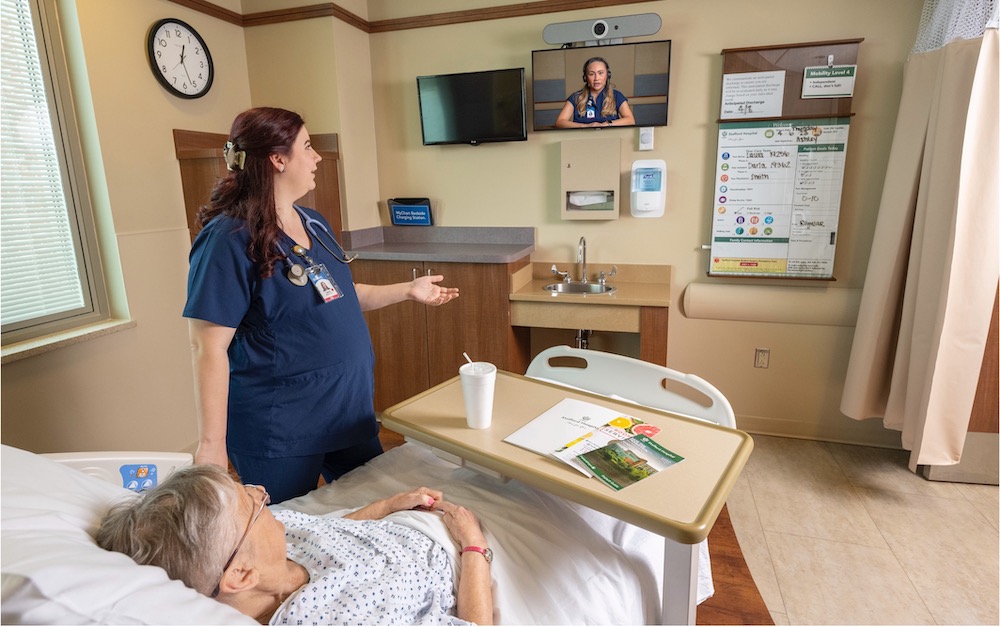Table of Contents

Photo courtesy of Mary Washington Healthcare
Facing high workloads and unprecedented levels of stress, nearly 100,000 nurses quit during the pandemic, according to a recent study. And it’s going to get worse — the same study projects that nearly 800,000 more nurses will quit or retire by 2027.
“I’ve experienced several nursing shortages over the past several decades, and historically, those shortages have largely resolved themselves over time,” said nurse and attorney Carol Boston-Fleischhauer, chief clinical officer at virtual nursing company Banyan Medical Systems in Omaha, Neb., during a recent podcast on Healthcare IT Today. “This shortage is different for all sorts of reasons and, unfortunately or fortunately, requires an entirely different set of solutions. Tactics that we’ve used in the past just aren’t going to make it.”
Some hospitals are turning to virtual nursing to address the shortage.
Although there are several models for virtual nursing, the basic setup is as follows: Experienced nurses are hired to work remotely to help in-person nurses with administrative tasks such as processing hospital admissions and discharges, reviewing medication lists for accuracy, creating documentation and educating patients. They can communicate with patients and hospital personnel on site through two-way cameras and microphones stationed in patient rooms. This frees up nurses working on the floor to focus on direct patient care. Virtual nurses also can participate in patient rounds with in-person teams or answer patient questions as they arise.
It’s a “tech-enabled staffing innovation,” Boston-Fleischhauer said in the podcast interview. Some virtual nursing pilot programs have improved nurse and patient satisfaction ratings, decreased overtime and decreased turnover, she said.
Virtual nurses don’t have to be local, either. HCA Healthcare in Nashville has a virtual nursing command center in Denver that monitors patients across eight hospitals in two states, Becker’s Health IT reported. About 65 staffers watch patients’ vital signs remotely, help with paperwork and check on high-risk patients via video. Virtual nurses also help train younger, in-person nurses. For a peek at how this works, see this story from CBS News Colorado.
Mercy Virtual Care Center, a facility dedicated to telehealth services in the St. Louis area since 2015, also employs virtual nurses. Virtual nursing “improves patient coverage by putting eyes and ears in every room,” nurse Wendy Deibert, vice president of telehealth services at the center, told Healthcare IT News. “It empowers patients and care team members at the bedside to bring in clinical reinforcement, specialists, translators and patient family members virtually when needed. Virtual nurses can act as a second line of defense for new, less-experienced nurses, many of whom received limited hands-on training during the pandemic.”
Virtual nursing examples across the country
Virtual nursing is also one of the biggest digital health trends for 2023, a group of health system digital leaders recently told Becker’s Health IT.
Here’s how some health systems are incorporating virtual nursing, and the results they are seeing:
- Providence, a health system in Renton, Wash., brought virtual nursing to nine hospitals in four states, Becker’s Health IT reported. With their co-caring model, virtual nurses working from home support bedside nurses and technicians by helping with tasks like admissions, discharges and preprocedural checklists. Results so far have been positive, with patients sending thank-you letters after discharge. At Covenant Medical Center in Lubbock, Texas, first-year turnover rates fell by 73% for registered nurses and 55% overall.
- Chicago-based CommonSpirit Health told Becker’s Health IT they plan to have virtual nurses in each of its markets by the end of the year, and across the entire system within five years. The health system, comprising 140 hospitals across 21 states, has two types of virtual nurses: Those who work at a command center to help with admissions, discharges and transfers, and those who are part of the care team attending rounds with physicians and on-call for patients 24/7. Early results from Saint Joseph Hospital in Lexington, Ky., have been positive, with higher patient satisfaction scores, decreased lengths of stay, decreased infections and decreased falls.
- Mary Washington Healthcare in Fredericksburg, Va., partnered with telehealth company Caregility to launch virtual nursing at Stafford Hospital, Becker’s Health IT reported. The program allows nurses in a virtual hub to take questions and perform non-hands-on care through a bedside monitor.
- AdventHealth in Altamonte Springs, Fla., also began a virtual nursing pilot program this year at Fish Memorial in Orange City and inpatient units in other hospitals, according to Becker’s Hospital Review. Patients who agree to the virtual nurse component have access to a registered nurse working off-site via a webcam in their room. Nursing turnover at Fish Memorial has gone from nearly 39% to 8.1% due to virtual nursing and other initiatives, Becker’s Hospital Review reported.
Story angles to consider
- How are virtual nursing programs being implemented and received at hospitals in your area?
- How do virtual nursing programs affect metrics like nursing turnover, infection rates or fall rates?
- What types of monitors and communication systems are being used?
- How are nurses — both virtual and in-person — reacting to these setups?
- What are patients’ thoughts on virtual nursing?
- What types of cybersecurity measures are in place to protect patients’ health information and secure video feeds?




More Stories
Thoughts as of late: on evolving, growing & that tiny voice inside
County Health Officials Report 17% Increase in Tuberculosis Cases
10 Most Nutrient-Rich Foods To Include In Your Diet